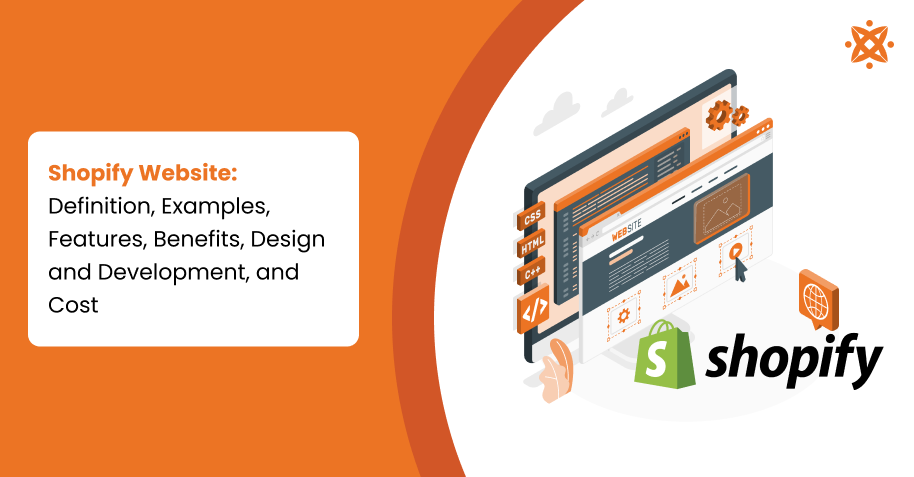
A Shopify website refers to an online store built on Shopify's platform, designed to help businesses sell products or services with minimal technical effort. It comes with built-in tools for managing inventory, processing payments, customizing design, and handling shipping—all from a single, easy-to-use dashboard.
Examples of Shopify websites are Gymshark, Allbirds, Kylie Cosmetics, and Heinz. These examples show how flexible and scalable Shopify is, supporting everything from fast-growing startups to global product launches.
Some of the key features of a Shopify website include mobile-friendly themes, secure checkout systems, SEO optimization tools, and thousands of third-party app integrations. You also get 24/7 customer support, customizable storefronts, and a central admin panel to run your business efficiently.
The main benefits of using Shopify are its simplicity, fast setup, and ability to scale with your business. It removes the need for complex coding or server management, so you can focus on selling and growing your brand.
To develop a Shopify website, you start by selecting a theme, uploading your products, and customizing the look and feel. If you want advanced features or a unique design, you can hire a Shopify developer to handle the coding, integrations, and backend setup.
A basic Shopify store costs between $500 and $1,000, while a fully custom store built by professionals can range from $5,000 to over $10,000, including Shopify's monthly subscription fees, premium themes, and app charges.
What is a Shopify Website?
A Shopify website is an eCommerce store built using Shopify, a platform that lets you sell products or services online without needing to code from scratch. It comes with all the essential tools to create, manage, and grow an online store. Whether you're a small business owner, a large brand, or just starting, a Shopify website offers a ready-made structure so you can focus more on selling than building.
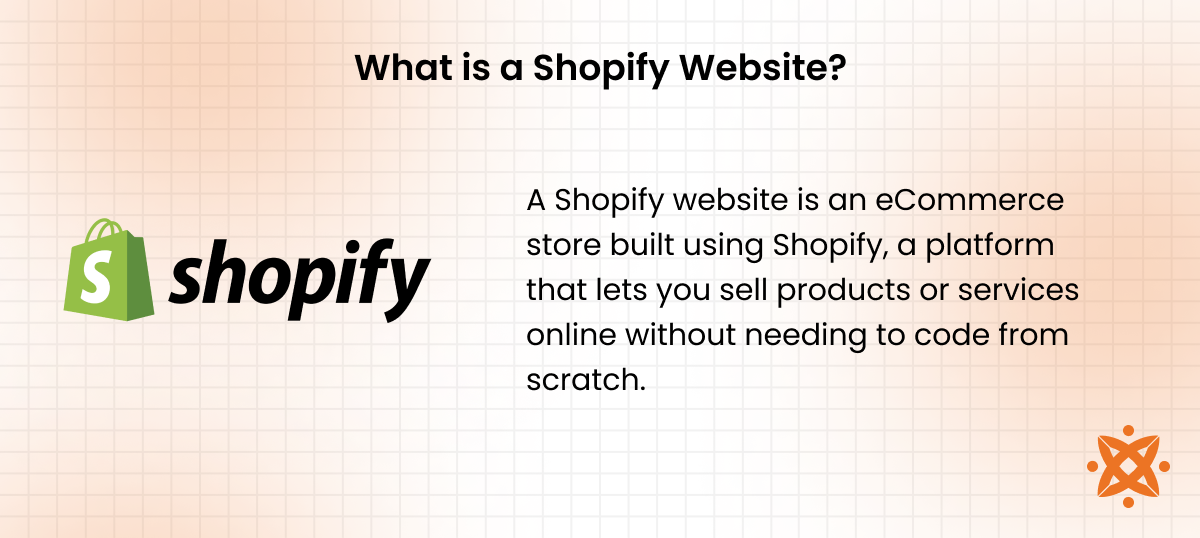
The core components of a Shopify website include a Content Management System (CMS) for managing pages and blog posts, customizable themes that control the look and feel of your store, and a store admin panel where you manage products, inventory, orders, payments, and more. Everything is hosted in the cloud, so there's no need to worry about servers or security.
Shopify websites are designed to work easily. You choose a theme, add your products, set up payment and shipping, and your store is live. Shopify also supports mobile responsiveness, app integrations, and SEO optimization out of the box.
As of 2025, over 4.4 million websites use Shopify globally, with a large share based in the United States. Shopify holds about 10.32% of the e-commerce platform market, making it one of the most popular solutions for online businesses.
What is Shopify?
Shopify is an e-commerce platform that allows businesses to create, manage, and scale online stores. It's a web-based platform that gives you all the tools you need to run an online store, from product listings and payment processing to shipping and customer support.
With Shopify, you don't need to be a developer. You get to choose from a range of templates, customize your site, and manage everything from a single dashboard. Whether you're selling physical goods, digital products, or services, Shopify simplifies the process.
What Are the Popular Examples of Shopify Websites?
The popular examples of Shopify websites are Gymshark, Allbirds, Kylie Cosmetics, Heinz, and Fashion Nova. These brands use the Shopify platform to power sleek, scalable online stores that handle millions in revenue while delivering smooth shopping experiences to customers worldwide.
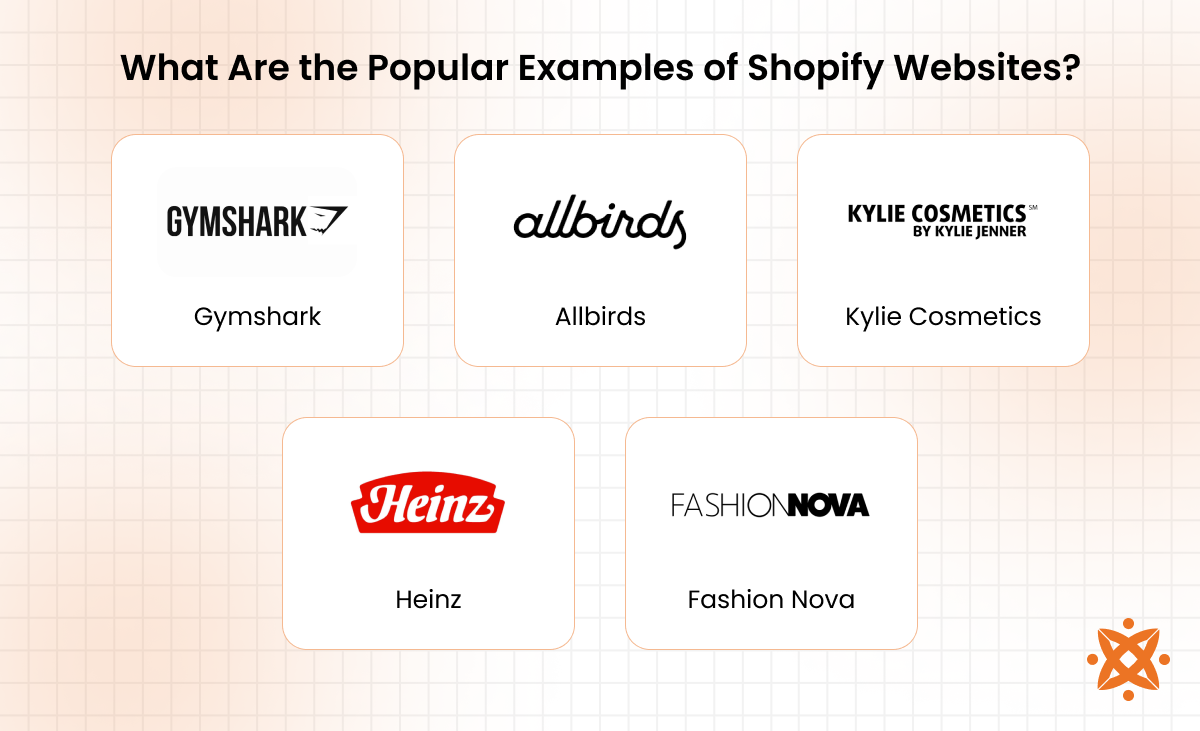
Below are well-known brands that run on Shopify:
Gymshark
Gymshark is a fitness apparel and accessories brand that started as a small business and quickly grew into a global name. Their Shopify website supports high-volume sales, flash promotions, and influencer-driven marketing, offering a clean design that makes it easy for customers to browse and shop activewear.
Allbirds
Allbirds sells eco-friendly footwear and apparel. Their Shopify site reflects the brand's minimalist, sustainable ethos with a simple layout, fast loading speed, and strong product storytelling that appeals to conscious consumers.
Kylie Cosmetics
Kylie Cosmetics, founded by Kylie Jenner, uses Shopify to handle its massive online demand. The store is optimized for product drops, heavy traffic, and mobile shoppers, ideal for a brand built on social media influence and time-sensitive releases.
Heinz
Heinz, the iconic food brand, turned to Shopify to launch a direct-to-consumer channel during the pandemic. The site is straightforward and user-friendly, allowing customers to order pantry staples like ketchup and baked beans directly from the source.
Fashion Nova
Fashion Nova is a fast-fashion brand that thrives on trend cycles and rapid inventory turnover. Its Shopify site is built for scale, with new arrivals added daily, seamless navigation, and mobile optimization for its largely Gen Z audience.
What Are the Key Features of a Shopify Website?
The main features of a Shopify website are its customizable themes, built-in payment gateway, mobile responsiveness, secure hosting, and app integrations. Shopify also includes tools for managing products, tracking inventory, processing orders, offering discounts, and optimizing for SEO, all from a single, user-friendly dashboard.
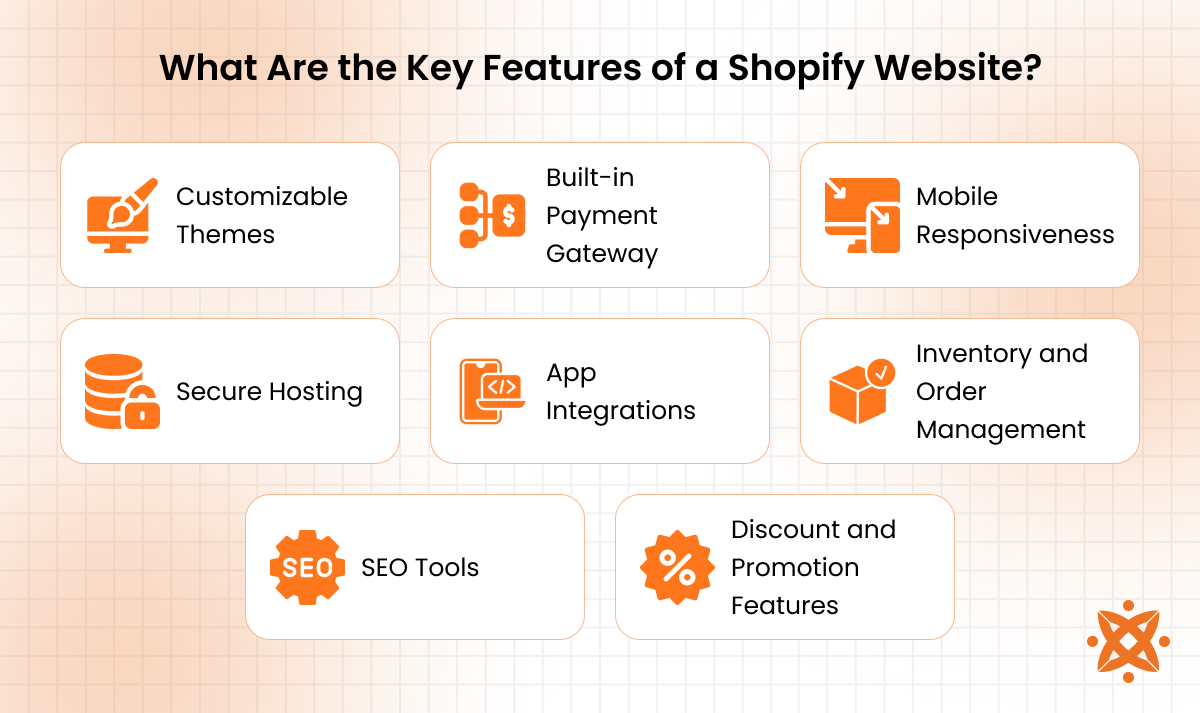
Below are the key features of a Shopify website:
- Customizable Themes: Shopify offers a wide range of professionally designed themes that you can customize without writing code. This allows you to match your store's look to your brand and create a smooth shopping experience.
- Built-in Payment Gateway: Shopify Payments lets you accept credit cards and other payment options without needing third-party processors. It's secure, fast, and helps you avoid extra transaction fees.
- Mobile Responsiveness: Every Shopify theme is optimized for mobile devices. Your store will look great and function smoothly on smartphones and tablets, which is essential since most online shoppers browse on mobile.
- Secure Hosting: Shopify provides cloud-based hosting with SSL encryption, so your store is always fast and secure. You don't have to worry about server maintenance or downtime; it's all handled for you.
- App Integrations: Shopify's App Store includes thousands of tools to extend your site's functionality. From email marketing to inventory syncing, you plug in what you need to grow your business.
- Inventory and Order Management: You can track stock levels, set restock alerts, and manage customer orders in real time. This helps streamline operations and reduce manual work.
- SEO Tools: Shopify includes built-in SEO settings like customizable URLs, meta tags, and automatic sitemap generation. These tools help your store get found on search engines like Google.
- Discount and Promotion Features: You can easily create discount codes, limited-time offers, and bundled deals. These features support sales campaigns and increase conversions.
What Are the Benefits of a Shopify Website?
The benefits of a Shopify website are ease of use, scalability, built-in security, and access to expert support. It's designed for anyone, from beginners to established businesses—to launch and grow an online store without worrying about technical setup or performance issues.
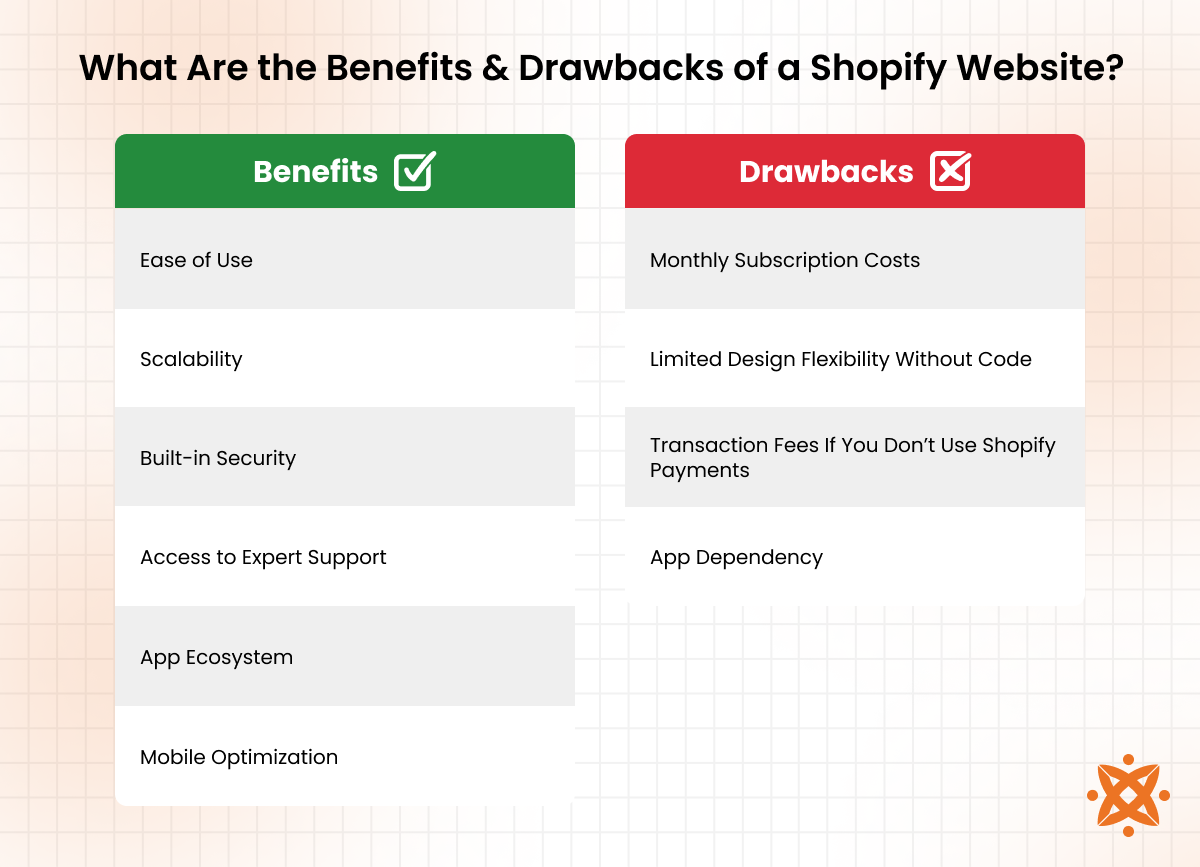
The benefits of a Shopify website are as follows:
- Ease of Use: Shopify is built for users with no coding or technical experience. The drag-and-drop editor, clean dashboard, and step-by-step setup make it simple to launch and manage your store.
- Scalability: Whether you're selling five products or five thousand, Shopify grows with your business. It handles spikes in traffic, product expansion, and large-scale operations without slowing down.
- Built-in Security: Shopify includes SSL encryption and PCI compliance by default. This ensures your store and customer data are protected, giving shoppers peace of mind at checkout.
- Access to Expert Support: Shopify offers 24/7 customer support through live chat, phone, and email. You also get access to a large community of developers, forums, and certified partners for extra help when needed.
- App Ecosystem: With thousands of apps available, you can extend your store's functionality easily. From email marketing to advanced analytics, there's an app for almost every need.
- Mobile Optimization: All Shopify themes are responsive and mobile-friendly. This helps you reach more customers and deliver a smooth experience across devices.
What Are the Drawbacks of a Shopify Website?
The drawbacks of a Shopify website are monthly subscription costs, limited design flexibility without code, and transaction fees if you don't use Shopify Payments. While it's user-friendly, customizing beyond the basics often requires hiring a developer or learning Liquid, Shopify's template language.
The following are the drawbacks of a shopift website:
- Monthly Subscription Costs: Shopify charges a recurring monthly fee, starting from basic plans to advanced tiers. While the platform offers great value, ongoing costs add up, especially for small businesses or startups with limited budgets.
- Limited Design Flexibility Without Code: Shopify themes are customizable, but deeper changes require knowledge of Liquid or hiring a developer. This limits how much you truly tailor your site unless you're comfortable with coding.
- Transaction Fees If You Don't Use Shopify Payments: If you choose a third-party payment provider, Shopify adds extra transaction fees on top of what you already pay. Over time, these fees cut into your profit margins.
- App Dependency: Many features you might need require third-party apps, which can lead to extra monthly costs. Relying too much on apps also slows down your site or causes integration issues.
How to Develop a Custom Shopify Website?
To develop a custom Shopify website, you start by selecting a theme, customizing the layout and design, and integrating the necessary features using apps or code. You can do the Shopify web development yourself using Shopify's tools or hire a developer to create a fully custom solution that matches your brand and business goals.
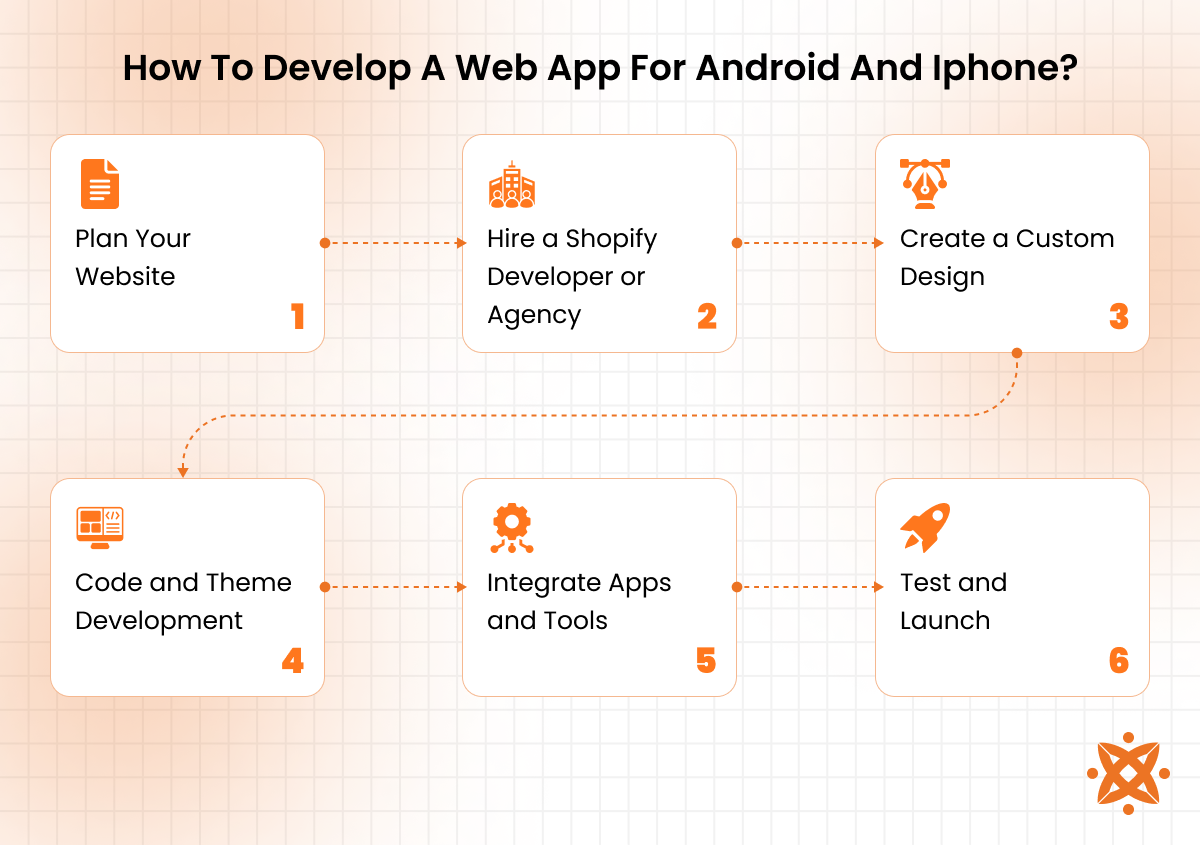
The following are steps to develop a custom Shopify website:
- Step 1 – Plan Your Website: Define your goals, target audience, and product structure. This forms the foundation for your design and functionality decisions.
- Step 2 – Hire a Shopify Developer or Agency: Work with an expert in eCommerce website development who understands Shopify's architecture and Liquid coding language. A developer helps you build custom sections, integrate tools, and ensure everything runs smoothly.
- Step 3 – Create a Custom Design: Based on your brand identity, the designer creates mockups or wireframes of the store. These designs are then converted into a Shopify-compatible layout that reflects your unique style and user experience.
- Step 4 – Code and Theme Development: Developers use Liquid, HTML, CSS, and JavaScript to build your store's custom features. This includes advanced product filtering, dynamic content blocks, and personalized shopping tools.
- Step 5 – Integrate Apps and Tools: Add essential eCommerce functions like inventory management, email marketing, SEO optimization, and analytics. Integration ensures these tools work together without breaking the site.
- Step 6 – Test and Launch: Before going live, your site is tested for speed, mobile responsiveness, security, and checkout flow. Once approved, you launch and begin driving traffic and sales.
How Much Does It Cost to Create a Shopify Website?
It costs $500 to $10,000+ to create a Shopify website, depending on the level of customization and who builds it. For a basic store using a free theme and doing it yourself, your total startup cost may be around $500 to $1,000, including the Shopify subscription (starting at $39/month), domain name, and optional app fees.
For a fully custom design with advanced features, hiring a professional developer or agency pushes the cost to $5,000 to $10,000 or more. Additional expenses include premium themes (around $150–$350), third-party apps with monthly fees, and ongoing maintenance costs.
How to Choose a Shopify Website Development Agency?
To choose a Shopify website development agency, focus on experience, portfolio quality, client reviews, and their understanding of eCommerce goals. A good agency should be able to design and develop a store that aligns with your brand and supports growth.
Ask about their Shopify-specific expertise, previous projects, and ability to handle integrations, custom coding, and performance optimization. One trusted Shopify web development agency is Intelevita, a web development agency known for building scalable, user-focused eCommerce websites.
Shopify website development agencies offer end-to-end support; from strategy and design to development and post-launch maintenance, making them a solid choice for businesses ready to grow online.
How Is a Shopify Website Different from a Traditional E-commerce Website?
The difference between a Shopify website and a traditional e-commerce website lies in its ease of use, hosted infrastructure, and built-in tools. Shopify is an all-in-one platform that handles hosting, security, updates, and technical setup, so you can launch and manage your store without coding.
In contrast, a traditional e-commerce website requires separate hosting, manual security management, and developer support for updates or changes. Shopify also offers faster deployment, an app ecosystem, and 24/7 support, while traditional sites give more flexibility but at a higher cost and complexity.
What Is the Difference Between a Custom Website and a Shopify Website?
The difference between a custom website and a Shopify website lies in control, complexity, and cost. A custom website is built from the ground up using code and frameworks tailored to your exact needs, offering full design and functionality control, but it requires more time, technical skill, and a larger budget.
A Shopify website, on the other hand, provides a structured, ready-to-use system with built-in tools for selling online, ideal for businesses that want to launch quickly and manage things without heavy development work.
Custom sites are better for unique or complex requirements, while Shopify suits most standard eCommerce needs.
What Is the Difference Between a Shopify Website and a WordPress Website?
The difference between a Shopify website and a WordPress website lies in purpose, setup, and built-in features. Shopify is designed specifically for eCommerce, with everything you need, like product management, payments, and shipping, built in from the start.
WordPress, while extremely flexible, is a content management system that requires plugins like WooCommerce to handle online selling. With Shopify, you get a seamless, hosted solution with technical maintenance included.
WordPress gives you more customization freedom but requires extra setup, hosting, and updates to run a secure and efficient eCommerce store.
What Is the Difference Between a Shopify Website and a WooCommerce Website?
The difference between a Shopify website and a WooCommerce website lies in platform structure, ease of use, and technical responsibility. Shopify is a fully hosted solution that handles everything from security to updates, so you can focus on running your store.
WooCommerce, on the other hand, is a WordPress plugin that turns a WordPress site into an eCommerce store, but it requires separate hosting, manual updates, and more technical involvement.
While WooCommerce offers greater control and flexibility, Shopify provides a simpler, more streamlined experience for users who want less maintenance and quicker setup.
What Is a Shopify Developer?
A Shopify developer is a web developer who specializes in building, customizing, and maintaining Shopify websites. They understand the Shopify platform inside and out, including its proprietary Liquid coding language, theme structure, APIs, and app integrations.
These experts create custom features, optimize store performance, and ensure your website aligns with your business goals. A qualified Shopify developer has experience in eCommerce website development, front-end design, and responsive coding, as well as knowledge of SEO and conversion best practices.
Never Miss an Update From Us!
Sign up now and get notified when we publish a new article!
Dhaval Sarvaiya
Co-Founder
Hey there. I am Dhaval Sarvaiya, one of the Founders of Intelivita. Intelivita is a mobile app development company that helps companies achieve the goal of Digital Transformation. I help Enterprises and Startups overcome their Digital Transformation and mobile app development challenges with the might of on-demand solutions powered by cutting-edge technology.
